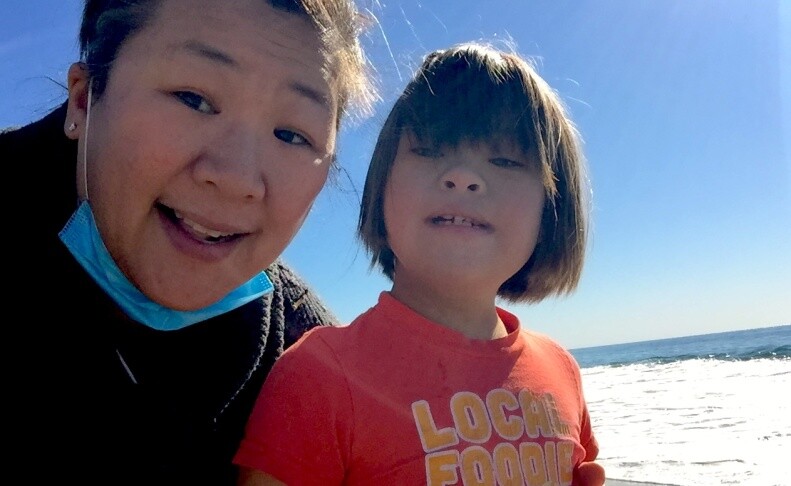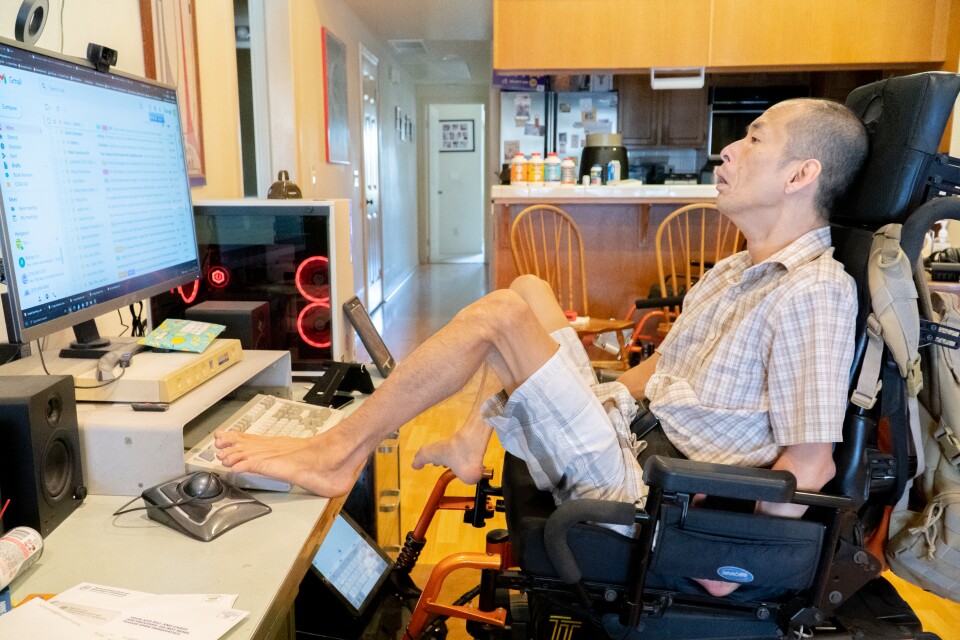Truth matters. Community matters. Your support makes both possible. LAist is one of the few places where news remains independent and free from political and corporate influence. Stand up for truth and for LAist. Make your year-end tax-deductible gift now.
The Historic Federal COVID Health Emergency Is Over, But The Pandemic’s Effects Are Here To Stay

On May 11, the federal COVID-19 public health emergency expires. It marks the official end of a pandemic that has now killed more than 1.1 million people in the United States and more than 101,700 people in California. According to public health officials, 36,200 of them lived in L.A. County.
Lifting the public health emergency is a sign that progress has been made, but officials acknowledge the virus is here to stay.
Beyond the statistics are people in our community continuing to grieve or adjust to severe and debilitating symptoms after contracting the virus. Throughout the pandemic, LAist told the stories of Angelenos striving to heal sick patients while working in besieged hospitals and of those advocating for representation. As the persistent threat of infection hangs over the official end of the COVID pandemic, LAist checked back in with three people we interviewed in the last three years to see how the pandemic changed them and their hopes for the future.
Jun Jai: A nurse’s view from the ICU

Throughout the pandemic, intensive care units rapidly filled up with the worst COVID-19 cases, putting extreme strain on critical-care teams — especially the nurses. The stress and uncertainty caused many health workers to leave the profession and nearly a third of nurses nationwide say they are likely to leave. Some however, continued to treat critically ill patients.
For more than three years, Jun Jai has treated the sickest COVID-19 patients in the ICU. He works at L.A. General, formerly known as LAC+USC Medical Center, one of the county’s largest public hospitals.
“I feel very proud of myself and my coworkers who are still fighting on the frontline. It feels like an achievement,” Jai said.
Since 2020, hospitals in L.A. County have recorded over 176,000 COVID hospitalizations. More than 33,000 of them were in ICUs.

“We had to go into the room and discontinue the lines and wrap the body,” he said. “There were so many people dying.”
Families were barred from entering the hospital, leaving nurses to handle every aspect of death.
“Sometimes we had to go in the room and pray for the patient,” he said. “Some nurses didn’t want to go in.”
COVID Patients Continue
Since 2020, hospitals in L.A. County recorded more than 176,000 COVID hospitalizations. More than 33,000 of them were in ICUs. That does not include hospitals in Long Beach and Pasadena, which have their own health departments. A single person could be counted multiple times if they were infected with COVID and hospitalized for each infection. Data as of May 4, 2023.
The stress caused many health workers and support staff to quit, or look for health care jobs outside of hospital settings. To cope after his 12-hour shifts, Jai tried to think about something completely different — home improvement projects.
“You have to keep busy. I would think about what color I wanted to paint a wall. I learned a lot on YouTube. You kind of switch away from the hospital stress,” he said.
Massive winter surges left hospitals woefully understaffed for the flood of patients requiring intensive care. During one surge in 2021, Jai injured his shoulder turning a 400-pound patient by himself, because there was no one available to help, from orderlies to lead nurses.
“We were short on people. No break relief, no charge nurse so we were on our own,” he said.
I feel very proud of myself and my coworkers who are still fighting on the frontline. It feels like an achievement.
After 14 years of working in the ICU, Jai’s shoulder injury is forcing him to leave. He endures pain during every shift and his doctor told him he can’t keep aggravating the joint. He’s looking for a less physically demanding job, but he’ll still be a nurse.
“You still need to have a job to feed your family. My son is in college and we have to pay his tuition and it costs a lot,” he said.
Jai is also planning a trip to China this summer to see his mother. The last time he saw her, no one had heard of COVID.
Cindy Liu: Caring for a child with special needs

In 2021 during the first rollout of the then-new COVID vaccine, confusion and botched communication caused some eligible parents and family caregivers of people with disabilities in California to be turned away from vaccination sites.
“We had all the right stuff too, and we were still denied,” said Cindy Liu.
Her 11-year-old daughter has Down syndrome and autism. As her parent, Liu should have been at the front of the line, but when she tried to get her first shot at a vaccine site in Ventura County, Liu was turned away.
“When I think back, I feel sad,” she said, sitting in the sunny back yard at her home in Thousand Oaks. Staff at the vaccine site questioned her repeatedly and implied her documentation could have been faked, leaving her frustrated and demoralized.
She eventually got the vaccine, but feels like the experience was emblematic of people with disabilities and their caregivers.
Resources for parents of children with Down syndrome
“When resources are scarce, that is the challenge, to see who really sees who. I think with any community that is not part of the larger system in a meaningful way there's a constant burden of proof, a constant burden to educate,” she said.

As the parent of two children, Liu says the pandemic “feels like dog years, I've probably aged at least 15 years. I don't think my kids have.”
Liu advocates for greater access for people with disabilities and thinks there were some silver linings to the pandemic. Lockdowns caused public meetings and schooling to shift online, which Liu says allowed people with disabilities to more easily participate.
“They're the ones 20 years ago saying I could work from home, and now 'Oh, you have to work from home? I told you we could do this,'” she said.
But she’s afraid that technological access is now disappearing.
There's a lot of work to be done to dismantle systemic ableism and systemic bigotry against people with disabilities. More of us are joining that community through long COVID and otherwise.
“If you're looking at elected meetings or civic meetings, is that still going to happen? Will we go back to requiring in-person? And so you go back to limiting representation, limiting access, and a status quo of a system that didn't work pre-COVID,” Liu said.
The pandemic gave everyone a taste of what it’s like to be reliant on technology for connection. She hopes that insight will lead to more inclusive policies.
“There's a lot of work to be done to dismantle systemic ableism and systemic bigotry against people with disabilities. More of us are joining that community through long COVID and otherwise.”
Tim Jin: Vaccination remains top of mind

California health care workers were given the first chance to be vaccinated against the coronavirus in late 2020. The state later implemented a mandate with a September 2021 deadline that included a slew of California health workers in hospitals, clinics, nursing homes and adult day care centers.
Even though they do much of the same intimate work, in-home health aides, who are paid for through the state’s regional center network, were not included on that list. After LAist reported on the anger felt by people with intellectual and developmental disabilities who wanted the mandate expanded, state public health officials added in-home care aides. Tim Jin was a vocal proponent.
But that mandate has since been lifted, leaving Jin in a similar situation of needing to question each health aide.
Jin has cerebral palsy, and doesn’t have the use of his arms or hands. He communicates mainly by typing out sentences with his toes on an iPad, which is mounted next to his feet on his electric wheelchair.

Jin is 48 and has lived independently in an Orange County apartment for 22 years. He types and opens doors with his feet, but needs help with everyday tasks such as eating and getting dressed. Up to six health aides come in and out of his home every day.
“Since [vaccination] is no longer required, it’s like trusting their word. And since we are in a workforce crisis you are lucky enough if one applicant applies to your job posting,” he said.
In-home health aides like his are paid for through the state’s regional center network. The average salary for a health aide in California is $32,000 per year.
“I know a lot of people having staffing problems because our society doesn’t really label the care provider job as a career,” he said.
Mentally, on the social front, it’s been a struggle. There is always a second thought on my mind, if I should go to a wedding for example, and trying to figure out how many people I have to interact with because of the pandemic.
Professionally, Jin flourished in his job as a disability advocate during the pandemic. He credits work-from-home policies. But since he’s medically vulnerable, he still has to weigh the risks of every social situation.
“Mentally, on the social front, it’s been a struggle,” he said. “There is always a second thought on my mind, if I should go to a wedding for example, and trying to figure out how many people I have to interact with because of the pandemic.
He still requires his health aides to be vaccinated. Throughout the pandemic, he hasn’t contracted COVID.







